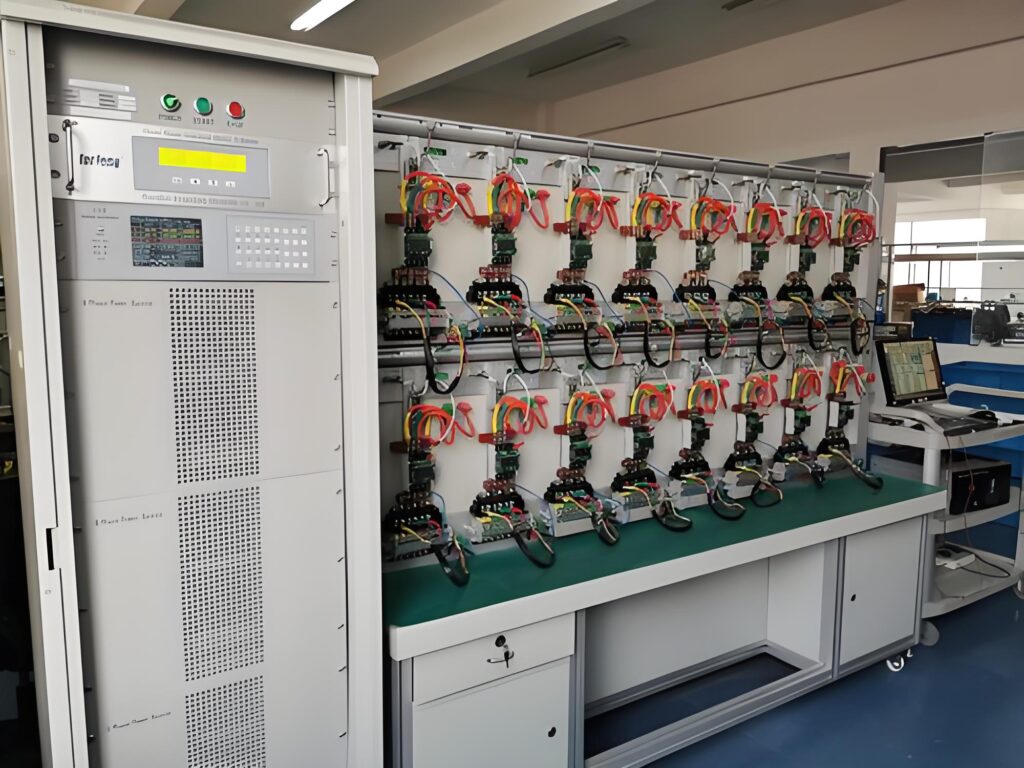Energy Meter PCBs
Premium Energy Meter PCBs at Competitive Prices
- Materials: FR4, High TG FR4, High-Speed FR4, PTFE, Polyimide
- Advanced Features: Impedance Control, Peelable Mask, Carbon Ink, Back Drill
- Via Options: Blind & Buried Vias, Micro Vias, HDI
- Via Plugging: Conductive & Non-Conductive
- Certifications: ISO9001:2015 Certified, UL Listed
- Standards: IPC-A-600 Class 2, Class 3
What is an Energy Meter PCB?
An energy meter PCB is a specialized circuit board designed to measure energy usage across various applications. Commonly utilized in residential, commercial, and industrial environments, these PCBs are crucial for monitoring and managing energy consumption. Equipped with sensors to measure voltage and current, the data collected is displayed on a monitor or LCD, offering precise energy readings in real-time.
Energy meter PCBs are vital for professionals in energy management, allowing for the tracking of consumption patterns and facilitating adjustments to optimize efficiency. With their advanced technology and reliability, energy meter PCBs are an essential component in both energy monitoring systems and research and development projects.
Request Your Free Quote Today!
Key Considerations for Energy Meter PCB Design
Designing an energy meter PCB requires careful attention to several factors to ensure optimal performance, durability, and electromagnetic compatibility. Here are the crucial aspects to consider:
1. Form Factor and Layout
- The PCB’s form factor, size, and chassis design are fundamental to its functionality. Electromagnetically sensitive components, such as power sources, digital components, and current return lines, should be positioned away from the board’s edges to minimize electromagnetic interference (EMI).
2. Material Selection
- Conductive Materials: The PCB requires materials with excellent conductivity and heat dissipation properties. Copper is widely used due to its cost-effectiveness and superior conductivity, making it ideal for wiring traces. While materials like silver or gold offer better conductivity, their high cost makes them less practical for large-scale production.
- Insulation Materials: The insulating layer, typically made from FR-4, must have low conductivity to effectively isolate the conductive layers and maintain the board’s integrity.
3. Component Placement
- Proper placement of components is essential for efficient PCB design. Key circuits, digital components, and power sources should be strategically placed, keeping the PCB periphery separated from these elements. The distance between components should be minimized to ensure reliable soldering.
4. Trace Layout
- Routing: Traces should be routed with adequate spacing—ideally, twice the width of the trace itself. Shielding traces are crucial to blocking noise, and different grounding mechanisms can be employed to enhance this effect.
- Current Return Path: Circuits should have a dedicated current return path, ideally along or beneath the signal trace routing, to prevent interference. A multi-layered circuit design can help manage power supply and electromagnetic behavior more effectively.
5. EMI Control
- Mitigation Strategies: EMI can disrupt the operation of an energy meter PCB, particularly in high-frequency environments. Effective EMI control strategies include:
- Ferrite Cores: Utilize ferrite cores on power lines to suppress EMI.
- Shielding: Apply shielding to cables and tracks to reduce interference.
- Ground Planes: Incorporate ground planes to provide a stable reference point for the circuit.
- Trace Design: Increase trace widths and design symmetrical layouts to minimize EMI effects.
- Board Stack-Up: Optimize the board stack-up to enhance signal integrity.
- EMI Filters/Suppressors: Use filters and suppressors to block unwanted signals.
- Bypass and Decoupling Capacitors: Properly size and place bypass and decoupling capacitors to filter noise and isolate sensitive components from noise sources.
Essential Components in an Energy Meter PCB
Designing an energy meter PCB involves integrating various critical components, each playing a unique and irreplaceable role in ensuring the board’s functionality and reliability. Here’s a look at the key components typically required in an energy meter PCB:
1. Voltage Regulator
- Purpose: The voltage regulator is crucial for maintaining a stable and reliable voltage supply, even when the input voltage fluctuates. It ensures that the application receives a consistent voltage, which is vital for the proper functioning of the energy meter.
2. Transducer
- Purpose: A transducer is essential for converting current values into corresponding voltage values. This conversion is critical for accurate measurement and monitoring of energy consumption.
3. Transistor
- Purpose: Transistors are vital components in switching applications within the energy meter PCB. They control the flow of electrical signals, acting as switches or amplifiers to manage the circuit’s operation.
4. Transformer
- Purpose: Transformers are used to modify voltage levels at different points in the PCB. While the power grid provides a standard voltage, various parts of the PCB may require different voltages, and transformers adjust these levels accordingly.
5. Capacitor
- Purpose: Capacitors are unique components that store electrical charge. They play a key role in smoothing out voltage fluctuations, filtering noise, and providing power reserves for the energy meter’s operations.
Why Do Energy Meter PCBs Need Microcontrollers?
Energy meters generate noise that can interfere with accurate measurements. To address this, microcontrollers are essential in energy meter PCBs. They help reduce noise interference and mitigate the impact of electrostatic discharge, ensuring that the meter provides accurate readings. By utilizing microcontrollers, the likelihood of misreadings due to electromagnetic disturbances is significantly minimized.
Why Choose LEAPPCB for Your Energy Meter PCB?
Choose LEAPPCB for your energy meter printed circuits and benefit from cost-effective, cutting-edge solutions provided by industry-leading professionals!
With extensive experience in manufacturing energy meter PCBs, LEAPPCB delivers unparalleled speed and precision, ensuring that your projects meet the highest standards of quality and reliability.
Need energy meter PCBs? Look no further! LEAPPCB is a trusted leader in PCB manufacturing, offering competitively priced boards that are tailored to meet your specific project requirements. Contact us today to get started!
Get Your Free Instant Quote Today!
Leap Electronic is your trusted partner and one-stop shop for PCB fabrication, component sourcing, PCB assembly, and electronic manufacturing. With over 16 years of expertise, we proudly serve over 1000 customers worldwide, delivering top-quality PCBs at competitive prices. Our ISO9001:2015 certification and UL listing ensure that all our products meet the highest industry standards. Every PCB is 100% E-tested and inspected using AOI and X-RAY, guaranteeing unparalleled reliability and performance.
Don’t wait – get an instant quote from our sales team today and experience the Leap Electronic difference. We’ll handle the rest!
Everything You Need to Know About Energy Meter PCBs
- Energy Efficiency Monitoring: Used in households and businesses to track and monitor energy efficiency.
- Energy Consumption Measurement: Essential for energy management systems to measure and analyze energy consumption levels.
- Energy Usage Optimization: Helps adjust energy usage to maximize savings and efficiency.
- Renewable Energy Tracking: Monitors energy production from renewable sources like solar or wind power.
- Automated Billing: Enables utility companies to automate billing processes based on accurate energy usage data.
- Peak Demand Calculation: Calculates peak demand charges to manage and optimize energy costs.
- Energy Irregularity Detection: Detects and diagnoses irregularities in energy consumption, improving system reliability.
An energy meter PCB tracks energy usage by measuring parameters like temperature, current draw, and efficiency ratings. When connected to an energy source, it records this data over time, which can be used for troubleshooting electrical issues or for billing purposes.
Is an Energy Meter PCB Reliable and Durable?
Yes, energy meter PCBs are designed to be both reliable and durable, ensuring long-term performance in various applications.
Safety Requirements for Energy Meter PCBs
To ensure safe operation, consider the following guidelines:
- Certification: Ensure the energy meter PCB meets all relevant safety certifications.
- Installation: Install in a dry, well-ventilated area, away from dust, dirt, and direct sunlight.
- Heat Sources: Keep the PCB away from heat sources to prevent damage.
- Flammable Materials: Avoid using the PCB near flammable materials.
- Proper Disposal: Dispose of the PCB responsibly at the end of its life cycle.
- Manual Instructions: Follow the manufacturer’s manual for correct operation and maintenance.
- Enhanced Energy Efficiency: Optimizes energy use, leading to significant energy savings.
- Cost Reduction: Helps reduce overall energy costs by monitoring and managing consumption effectively.
- Improved Safety and Reliability: Ensures stable operation with minimal risk of faults or failures.
- Lower Maintenance: Decreases maintenance requirements due to its durable and reliable design.
- Simplified Monitoring: Makes it easier to track and monitor energy usage in real-time.
- Better System Integration: Offers enhanced integration capabilities with other systems for comprehensive energy management.
